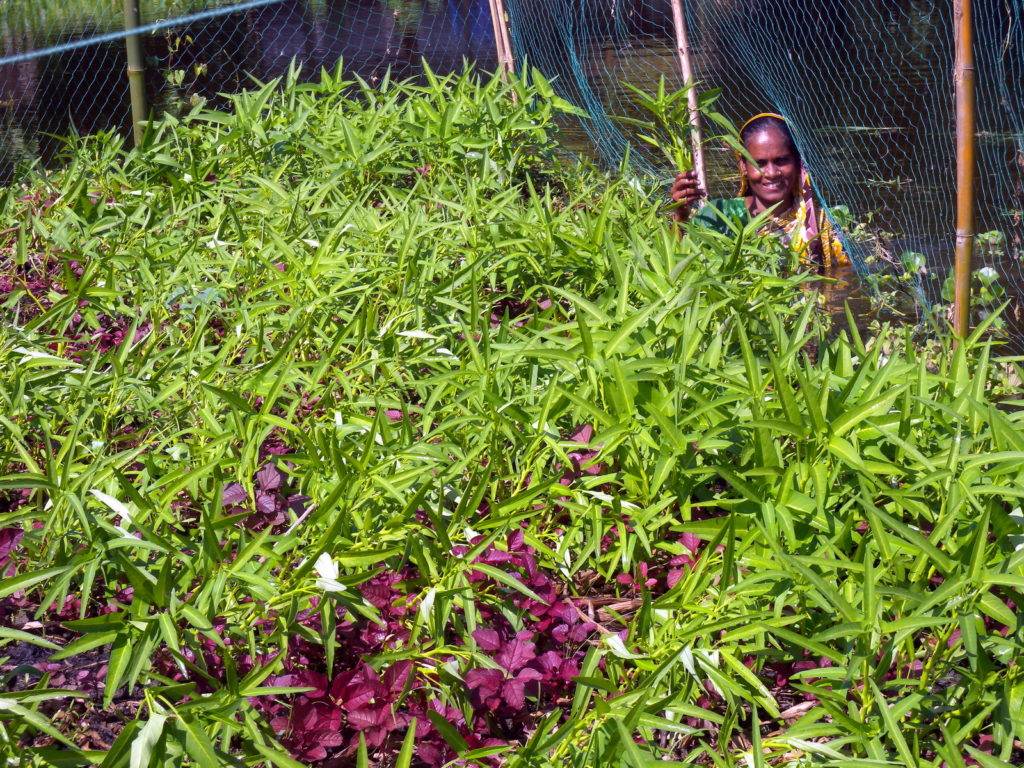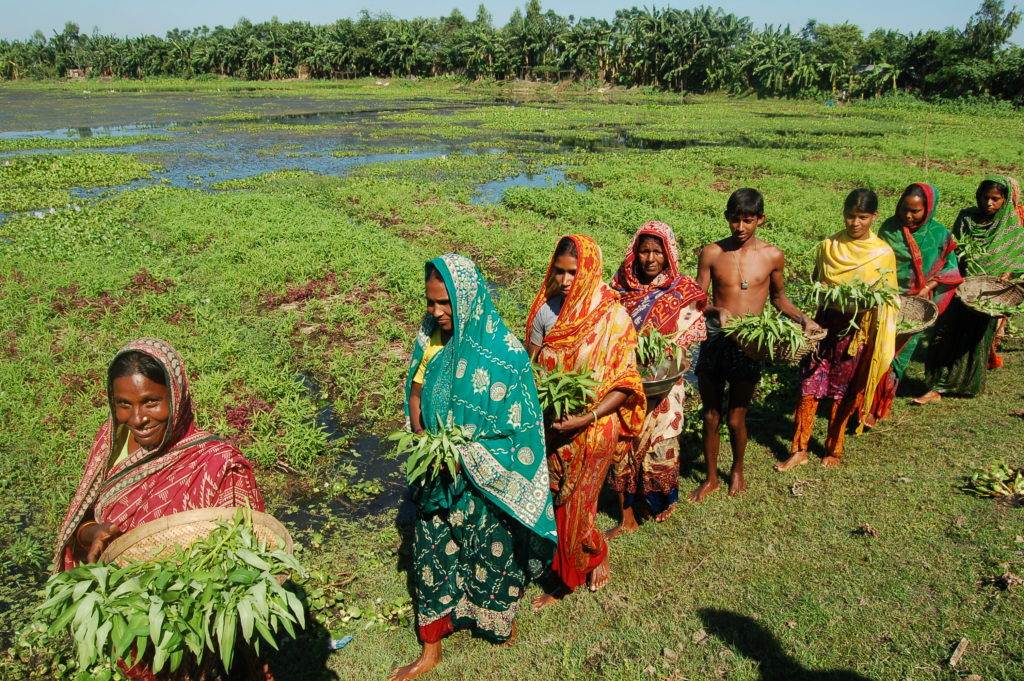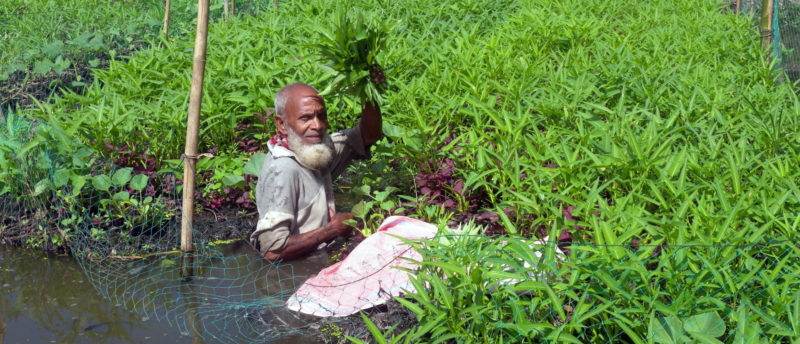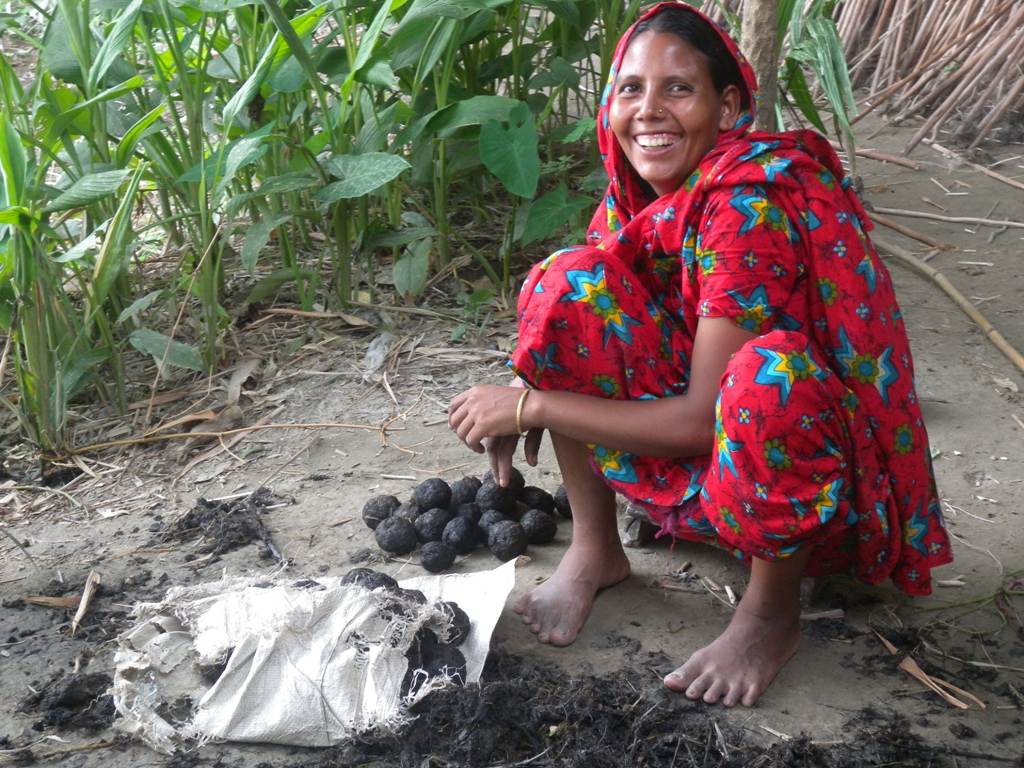Floating Gardens – A transformative, accessible approach to agriculture
In the face of climate change, Bangladesh’s floating gardens offer an exciting solution to the challenges faced by millions of farmers.
Floating gardens are nothing new, but they have lots to offer when looking for transformative and accessible approaches to agriculture. These brilliant, environmentally-friendly farms are an important part of our work in Bangladesh, helping create a supply of food and crops in areas where flooding dominates the annual weather cycle.
Faruk Ul Islam, from Practical Action Bangladesh, was recently interviewed on the subject for TRT, the Turkish Public Broadcast service: “Practical Action has been implementing these gardens in both northern and southern Bangladesh – they allow for food in areas where it’d otherwise be scarce.”

Floating gardens work in tandem with nature to allow crops to thrive, even in waterlogged areas.
For many years our staff have promoted these transformative ideas and now a new report from the Journal of Agriculture, Food and Environment has declared that floating gardens could provide a sustainable source of food for farmers working in flood-prone areas across Bangladesh to demonstrate that they can be adopted and taken to scale around the world.
“When the flooding recedes, farmers may not have much land available. Floating gardens help grow vegetables and have access to them close to home – even people without land have access to these resources. It’s very eco-friendly as the material used in these floating gardens is water hyacinths that naturally floats.”
Faruk Ul Islam, Practical Action Bangladesh
Why floating gardens?
Two-thirds of Bangladesh is wetland, meaning that huge areas of land are under water for periods of the year. This waterlogging creates a challenge, as the potential for growing crops in the traditional way is greatly reduced.
However, there are plants that flourish in Bangladesh’s rivers and wetland – water hyacinths, for instance – and are able to rise and fall with the water, like rafts. These plants can be used as a base from which food can be grown even when the rivers are at their highest. The result is floating gardens that are easily accessible, cost-effective, reliable and work totally in tandem with nature. In fact, The United Nations Food and Agricultural Organization has named Bangladesh’s floating gardens a Globally Important Agricultural Heritage System.

A reliable food supply in water-logged areas can be transformative for the community.
“In southern Bangladesh we’ve added to our methods by growing vegetables and catching fish in a cage system, so it’s like a floating farm where both fish and vegetables are integrated. This is especially useful in areas that are often waterlogged. This system of aquageoponic farming has many benefits.”
Faruk Ul Islam, Practical Action Bangladesh
How do floating gardens work?
Farming families will either use their own land for floating gardens or, if they are landless, will choose to rent. Renting land is very cost effective: for the equivalent of $8, a farmer can invest in 20 square metres of buoyant land for 4-5 months.
The gardens are created by weaving and layering the plants – normally about three feet deep – to create versions of raise-bed gardens, allowing them to operate as a growing base as they float. Vegetables are then planted inside these rafts, and as the plant-bases gradually decompose, they release nutrients, which help feed the vegetables.
Floating gardens are a great way to reliably grow popular vegetables. For communities in Bangladesh, that means traditional okra, gourd, spinach and aubergine. Spices can even be grown, including turmeric and ginger. If a farmer wishes to expand their floating garden, they also have the option to grow saplings.
Usually, within 3-4 months, the farmer will have a return of 16kg of vegetables. Operating costs are low, making it ideal for small-scale farmers – and if they wish to scale up their farming operation, they can rent more land and bigger units. Those now using floating gardens have even reported earning four times as much money as they did from operating traditional rice paddies.
In Southern Bangladesh, where waterlogged lands are most prevalent, Practical Action has also introduced cages, in which fish can be farmed. This provides additional income and nutrition, even in the wettest seasons. The plants that stem from the floating farm also absorb chemicals, making for clean fish farming with no hidden environmental or health costs.
More farmers now have an option to move away from rice crops – which are riskier in terms of crop yield and reduce the monocropping culture, which can be damaging to the environment. Instead, they are able to embrace floating gardens as a low-cost, accessible form of farming, backed by hundreds of years of local knowledge and experience.

“We’re going to continue replicating this floating garden system in many areas around the world. The farming mechanism and technique are widely applicable and can be adopted universally. The materials will be different in different places, but wherever smallholder farmers invest, they’ll get a great return on investment out of it.
We know floating gardens can succeed wherever in the world there’s waterlogging.”
Faruk Ul Islam, Practical Action Bangladesh
A growing practice
Floating gardens set an exciting precedent, and their sustainable and accessible design, along with their relatively low operating cost, has led experts to suggest they could offer an amazing farming solution around the world. You can already find floating gardens in Mexico, India, Cambodia and Myanmar. In each region, there are different options available to farmers in terms of the vegetables they can grow and fish they can catch, but the central model and philosophy remains the same.
Climate change presents a real threat for farming communities all around the world – but floating gardens present a way to keep producing food, providing means and offering a balanced diet. As more farming communities turn to floating gardens, they’re finding increased stability in both incoming and available crops, even in the face of the challenges of changing weather and unpredictable flooding.

These amazing floating gardens have the potential to create positive change across the globe!
Discover more about other pioneering climate-based adaptations, our work and how you can get involved with Practical Action.